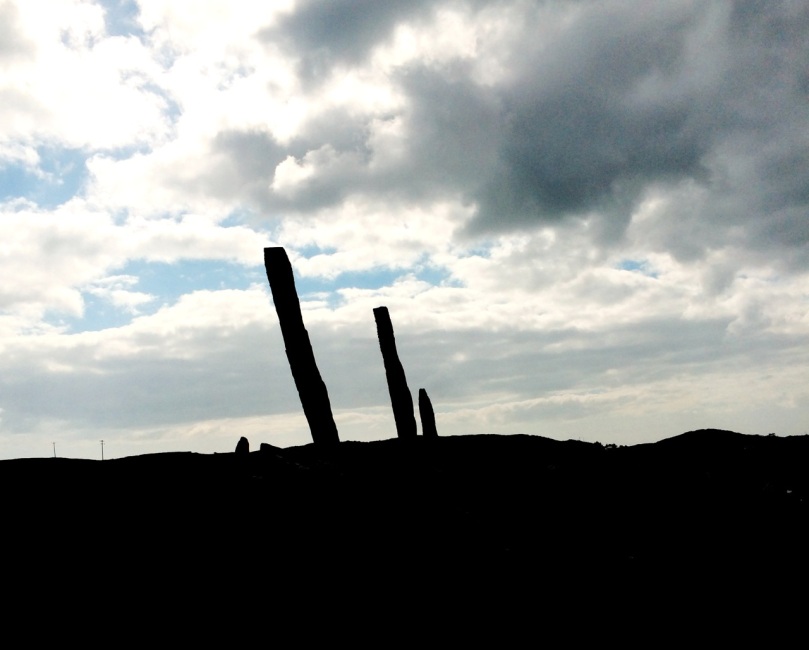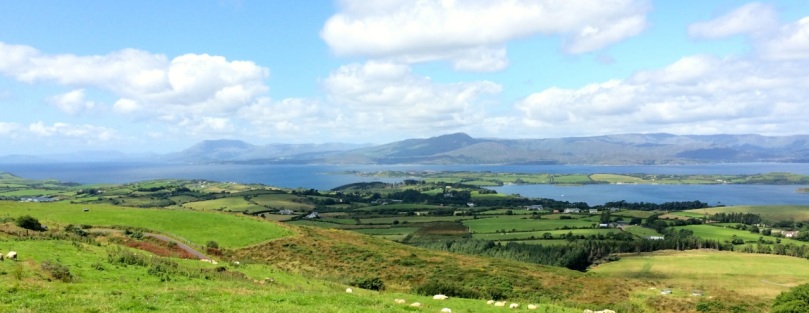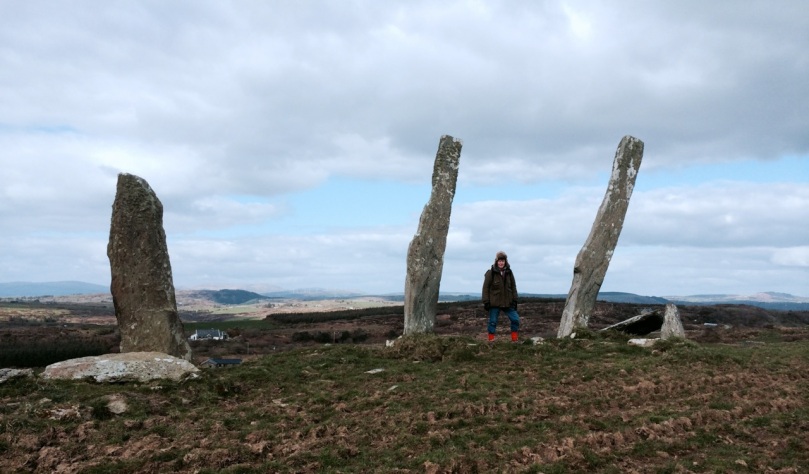All across West Cork – in the middle of pastureland, in isolated bogs, on the tops of mountains – you see standing stones. Mostly single but also found in pairs, or rows of three or more, they are as ubiquitous as they are mysterious. A scan of the Ordnance Survey map of the valleys running eastwards from Bantry, just north of us, shows a great proliferation of standing stones, and we have been tempted into the field often to hunt for them. We usually find them, but even when we don’t the search brings us into magnificent countryside.
The most numerous are, of course, single standing stones. The practice of erecting monoliths dates from the Neolithic and many of the stones we see may indeed be as old as that, or Bronze Age. Some may be medieval or more recent still – local people occasionally have memories of a grandfather placing a stone to act as a cattle scratching post.
If the stone has rock art on its surface, as is the case with the Burgatia stone near Rosscarbery, for example, we can safely conclude that it’s probably Bronze Age. Ogham incisions, or an inscribed cross will assist with an Early Medieval date. But the vast majority are unmarked and their functions may have varied. Some excavated examples have yielded evidence of burials at the base, and some seem to mark boundaries or entrances to mountain routeways.
Stone pairs and stone rows often occur in close proximity to other Bronze Age monuments such as stone circles and boulder burials. Some are further away from the monument but clearly visible from it.
Like the stone circles, the pair or row has an alignment – generally northeast/southwest, and a further alignment is formed from the two to the boulder burial or stone circle.
Irish folklore is rife with stories about standing stones. Many were said to have been hurled there from a nearby mountain by Finn McCool. Kevin Dannaher in his book Irish Customs and Beliefs relates several instances of petrification. Here’s an example:
…our early saints are…credited with passing fits of choler during which several miscreants were rendered harmless…When St Fiachna discovered that a dairy woman was stealing his butter he did not hesitate to loose a mighty curse against her, which turned not only herself, but her dairy and all her utensils as well, into stone. In proof of which they are still plain to be seen close to the saint’s church at Teampal Fiachna, a few miles south east of Kenmare.
One kind of standing stone is particularly intriguing – the holed stone. Tradition has it that these are marriage stones: the couple would join hands through the hole to exchange vows.
*Both holed stone photographs are by Amanda Clarke










sure he was just a big fairy, in all honesty
LikeLike
Can’t help wondering what Finn Mc Cool’s marriage stone looked like, him being a giant, like…
LikeLike
Hah! But he just had to get his hand through it, in fairness, like.
LikeLike
A great selection of photos and a fine essential history. Hope that idea is germinating nicely – heed thee to a marriage stone immediately!
LikeLike
Would you recommend one in particular?
LikeLike
Thanks for the lovely evocative photographs. BUT, I find somewhat off-putting the linking of such fascinating archaeological sites to “fairy tales” , for example, regarding standing stones, “hurled there from a nearby mountain by the giant Finn McCool” and “- – a mighty curse- – which turned not only herself, but her dairy and all her utensils as well, into stone -”
I don’t know where these ridiculous “fairy stories” come from. They have no basis in Irish legend or folklore (see “The Lore of Ireland” by Dáithí Ó hÓgáin], e.g. Fionn mac Cumhaill is never referred to as “a giant” in the actual legends. I see the linking of these sites to these stories as a kind of defacement of them, akin to graffiti. It’s a pity as the photographs and location information are very good.
LikeLike
Hi Tony. Thanks for your comments. I’m glad you liked the post on the whole. Having thought about it, I think you are right about Fionn not being a giant in the early lore, so I have taken out the word giant. There is no doubt that he is identified as a giant in certain folktales: but these may be of more recent vintage than the Fianna legends. However, I have personally heard stories from Irish country people about stones being hurled from mountain tops and about people, animals or objects being turned to stone – such stories being associated with standing stones and stone pairs/rows. Kevin Dannaher, whose work is generally held in esteem, collected the one I used in the piece.
Having spent much time in the field as an archaeologist and historian, I believe the folklore associated with prehistoric sites in Ireland enriches them, rather than debases or defaces them, and provides insights into the ethno-historical context of their place in the landscape. In this regard, I find the work of Howard Goldbaum particularly interesting, as recorded in his excellent site, Voices from the Dawn: http://www.voicesfromthedawn.com/
LikeLike
Thank you for your very interesting response. I understand your point and, of course, there’s room for different approaches. It’s just ME, I think. I wince, for example, when I see the síodh described as “fairies”.. I find the actuality of these sites and the idea of the síodh etc., Celtic legend and myth in general, so strange, mysterious and intriguing,-especially as our countryside is still so alive with it- that I dislike it being distorted by more recent, mainly 19th century, notions about giants, fairies and Brothers Grimm style istories. I loved the photos. It’s not easy to capture the mysteriousness of standing stones but those photos did. Did you take them? If you did, congratulations.
LikeLike
I’m with you most of the way. Your blood pressure count must really go up when you see the word Druid! I took all the photos except for the last two, identified as the work of Amanda Clarke.
>
LikeLike
Marriage!?
LikeLike
I like the marriage bit!
LikeLike
I wonder if the Irish government recognizes a holed-stone ceremony.
LikeLike
Beautiful photos… let us all know how that idea develops…
LikeLike
Yes…an interesting one…don’t you think?
LikeLike
Always good to be reminded how interesting this area is. Thank you. Great photos too.
LikeLike
Thanks, Tim! You must have lots around you, too.
LikeLike
Hello both, Very interesting blogs and you are certainly getting a lot out of being in Eire. Our son is involved in a strange project in Thailand called Megalith Movers – Prehistoric Engineering. Have a look at their website, particularly the Blog page. It has very loose links to what you are doing though more about the actual erecting of an obelisk using ancient techniques, apart from the concreteness of the obelisk!
Let us know when you are next over here. Lots of love to you both, Virginia and David
LikeLike
Hi Virginia – I took a look at http://megalithmovers.org/ what a fascinating site! I love this kind of experimental archaeology.
LikeLike
Wendy & I were at the Men-An-Tol on the Penwith Moors in West Cornwall once, when three ancient gentlemen dressed identically in sober black suits came and laboriously passed themselves backward through the holed stone. We thought they were probably two or three hundred years old but didn’t like to ask them in case they vanished.
LikeLike
Maybe they were getting younger!
LikeLike